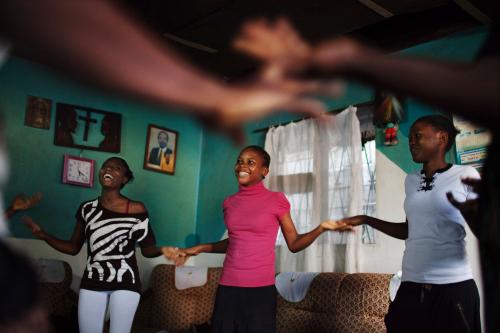This blog is a summary of our new report “Translating competencies to empowered action,” which can be downloaded here.
Today the buzz around life skills education for girls is at an all-time high. Policy and civil society actors—from United Nations agencies to grassroots community-based organizations—have made great strides developing life skills programming to help girls achieve a wide range of empowering cognitive, health, social, economic, and political outcomes. But in many cases, such newfound empowerment is met with violent backlash by family and community members, particularly when girls attempt to apply skills like communication, negotiation, or leadership outside of the safe spaces provided by a program. As a result, the burden of social change has been largely placed on the shoulders of the girl-child.
At Brookings, we are examining how policy and civil society actors can do a better job shifting that burden of change from girls themselves to her broader social and political context. As part of our larger work on Skills for a Changing World, we’re asking questions about how girls’ life skills programming can be better linked to transformative social change and the disruption of structural inequalities that sustain barriers for girls and women.
One answer is that life skills education should be more than just about the girl’s own skills development. Practitioners should also be focused on the girl’s agency (her capacity to see and to make choices) and whether enabling opportunity structures (like policies, social norms, and institutions) exist in her environment.
In our new framework on girls’ life skills education, we draw on the fields of gender empowerment and the psychology of learning to help practitioners better design life skills programming that connects girls’ life skills development not only to empowerment but also to wider social change. We’ve summarized this into four guiding principles:
1. Consider a broader range of competencies
For starters, practitioners need to conceptualize life skills as a range of competencies (what one can do) that enable girls (and boys) to function, thrive, and adapt in their lived realities, rather than a narrow set of skills for life. These competencies are comprised of networks of Knowledge (what one knows), Skills (what one has), and Attitudes (what one believes and values), or KSAs. Conceptualizing life skills in this way well help encourage practitioners to be more purposeful not only around the whats of life skills, but also the hows of applying such competencies to navigate unique challenges at pivotal moments across her life and in different contexts.
 2. Design for five touch points in programming
2. Design for five touch points in programming
Moving the focus of life skills programming beyond the girl means designing programs that begin with 1) the dynamic process of building girls’ competencies, but continue on to focus on: 2) whether the girl can translate her skills into 3) empowered action amidst a host of mediating factors that can influence the degree to which her action is empowered. And, if actors seek to achieve wider goals for girls and women, programs must also take into account 4) the range of life outcomes impacted as well as whether 5) systemic change has been achieved. (Watch our animation below for an illustration of how these five touch points come together.)
3. Be intentional about development and change
Evidence from the psychology of learning stresses the continuous, dialogical, and non-linear nature of skills development over the child’s life. Life skills development is no different. Practitioners must therefore be more intentional about building upon foundational KSAs throughout key moments of the girl’s life, including early childhood through adolescence and young adulthood.
But tied to development is change. This rings true not only at the individual level of the girl, but also for her wider social context. As girls build KSAs important for her empowerment, there is a consequent reaction and response by her peers, family, and community that must be accounted for by programs. This interaction can lead to the strengthening of her agency, as well as to the weakening of it.
4. Support girls to “read” context, gender, and power
Finally, if there is one “life skill” that we believe is foundational for girls, it is the ability to read her social, political, and economic contexts with an understanding of how gender and power have structured her realities and opportunities. Life skills programs must support girls to recognize, navigate, and leverage the dynamic structures in her life if she is to translate KSAs into empowered action. Without this, programs risk girls’ life skills development getting “stuck” in the safe spaces in which they are learned.
As the girls’ education community continues to center life skills across program, donor, and government policy priorities, we must ensure that actors take into account the urgent need to focus on more than just the girl’s skills development—lest we continue to place the burden of social change on girls themselves rather than on the gender unequal societies in which she lives. We acknowledge that this will be difficult to apply in practice, but catalyzing transformative social change has and will never be a straightforward process. Our hope is that by focusing on the above four principles, policy and civil society actors will be to push the field even further to ensure that life skills initiatives move girls and women toward both improved life outcomes and wider systemic change.





Commentary
Life skills education is more than teaching skills
November 21, 2017